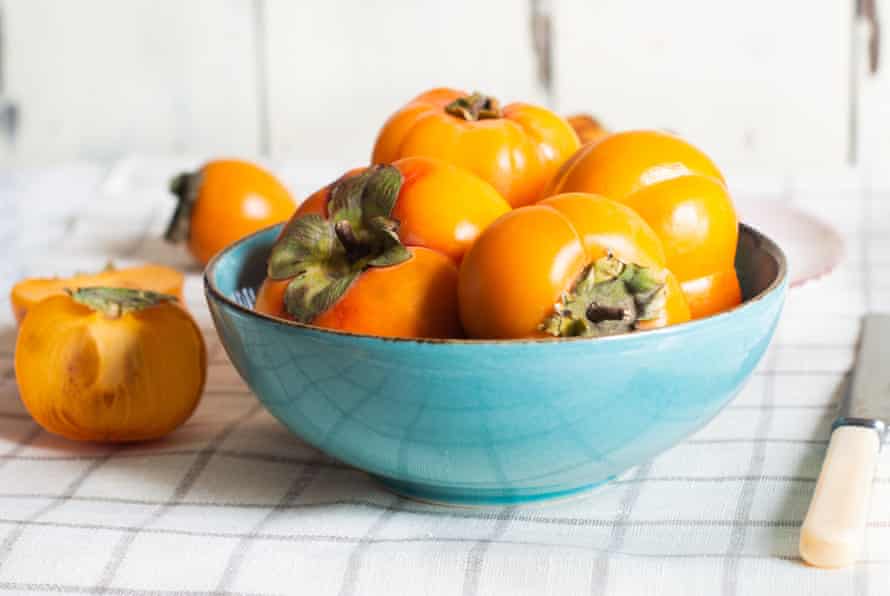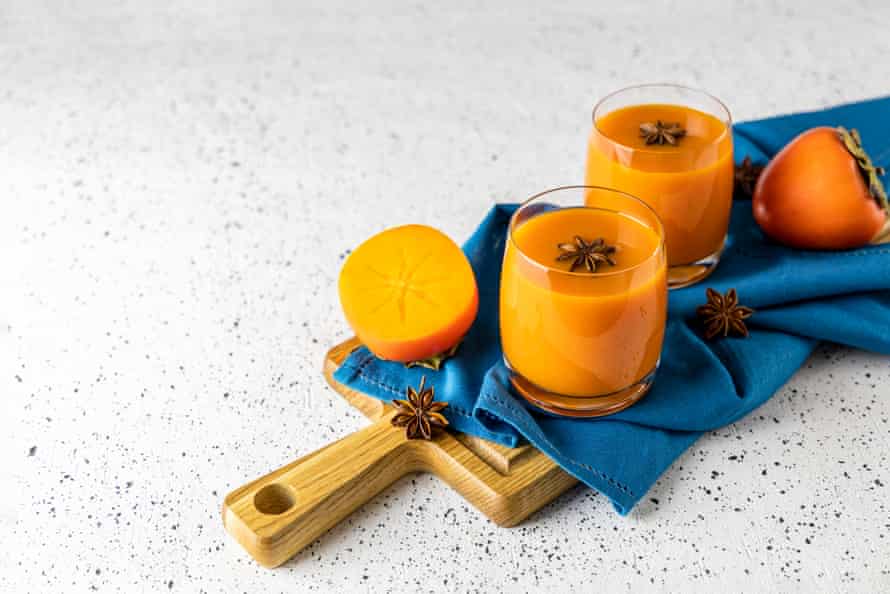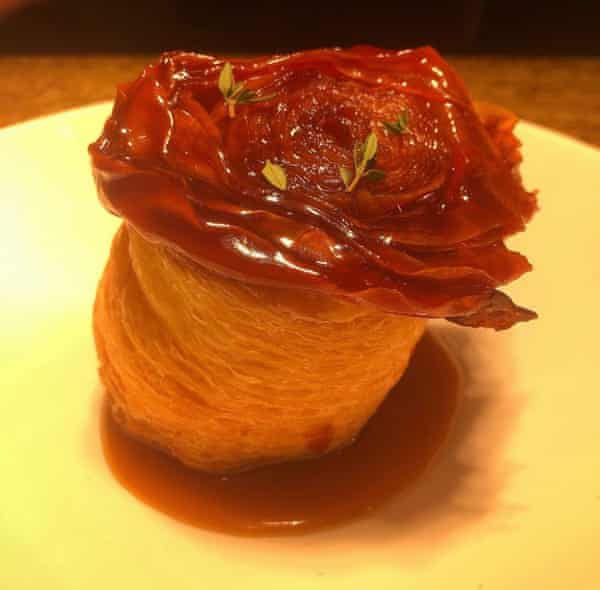
If ever a fruit seemed purpose-designed to lift spirits as we head into the darker, cooler months, it’s the persimmon. The jaunty pumpkin-coloured treat brings a pop of vivid orange to greengrocers’ shelves, and when ripe, adds a healthy helping of honeyed, date-like sweetness wherever it’s used.
This subtly flavoured fruit is attracting more attention in Australia but as a nation, we’ve been comparatively slow to warm to persimmons. Persimmons have been spreading cheer in China for millennia and the delicacy is so prized in Japan it’s the country’s national fruit. In Korea it’s called the Korean mango.
These tangerine-hued fruit began appearing in specialty grocers and some supermarkets recently. Traditionally the season runs from February until mid-June but La Niña forced a later start. “The season was looking real good in Queensland – but a lot of persimmons are grown near the coast and the metre of rain that arrived right before picking was a disaster,” says grower Chris Stillard, chairperson of Persimmon Australia, the industry’s peak body.
“Twenty years ago you’d never see a persimmon in a supermarket,” Stillard says. “Ninety-five percent of the fruit then went straight to Cabramatta, an Asian hub. Now we’re seeing small amounts on shelves of supermarkets as well as greengrocers.”
Two types in Australia: astringent and sweet
Suncoast Fresh supplies fruit and veg to restaurants and cafes in Queensland and northern New South Wales. Glenn Connor manages the Brisbane depot and says so far, persimmon sales are up 28% on last year. “We’re definitely selling more … a lot of higher-end chefs are looking for something different.”
The main fact to know about persimmons, Stillard says, is there are two distinct types on the Australian market. The first is the original or astringent persimmon which arrived in the 1850s. It’s thought these were brought by Chinese migrants during the gold rush.
Cultivation of non-astringent or sweet persimmons, the second style, didn’t start until the 70s. Botanically, astringent and non-astringent persimmon (genus Diospyros) belong to the ebenaceae family, a group which also includes ebony hardwood.
The Stillard family’s 283 hectare property is in Barooga in the Riverina, NSW. They’ve cultivated persimmon orchards for more than 30 years. Barring fresh disasters, Stillard says the NSW season looks very good for 2022, with NSW and Victoria jointly accounting for around 40% of persimmon production and Queensland contributing around 30%.
Stillard produces two varieties of sweet persimmon, the Jiro and the Fuyu. “The Jiro is a slightly flatter fruit and the Fuyu is rounder, but unless you really know your stuff you wouldn’t pick the difference,” says Stillard.

The Fuyu is the most popular variety sold in Australia. More than 95% of fruit sold domestically are this sweet, stubbier, non-astringent style of persimmon. “The Asian and eastern European markets prefer astringent persimmons. But the Australian market is all about the sweet or non-astringent persimmon.”
Sweet persimmons look a bit like smooth-skinned miniature Halloween pumpkins. They’re usually the size of a beefsteak tomato and can either be eaten firm or left to ripen until soft.
Teardrop or heart-shaped original astringent persimmon must always be left to fully ripen. They’re ready to eat only when their flesh softens and turns to jelly and the skin becomes translucent – any earlier and the tannic astringency is mouth-puckeringly nasty, like eating unripe banana. Ripening can be sped up by placing fruit in a paper bag with a banana for a few days. The ethylene released by the banana persuades the persimmon to soften. It is thought bad memories of trying unripe astringent persimmon may have turned some older Australians off the fruit.
Alanna Sapwell, head chef at Beach, Byron Bay, sources persimmons from Picone Exotics in Mullumbimby. John Picone cultivates an orchard of over 400 spray-free tropical and subtropical fruits. “He grows both astringent and non-astringent persimmon but I prefer non-astringent,” says Sapwell. “I love the flexibility of the fruit because it works in both sweet and savoury applications.”
One of the dishes which brought Sapwell national critical acclaim at Queensland’s now shuttered Arc Dining, featured house-made goose prosciutto draped over ribbons of sweet persimmon, with fresh curd and fig leaf oil. She’s also fermented the fruit like black garlic.

“A lot of people still haven’t tried persimmon before. Usually I describe it as looking a bit like a yellow tomato and tasting more like a pear but with a flavour that can go right the way through to rockmelon,” says Sapwell. “It’s hard to describe but it’s a very approachable fruit. I’d encourage anyone to try it. When they do, they usually end up wondering why they haven’t had it before.”
Sapwell says persimmons marry well with seafood and cured meats like prosciutto. They also work with vanilla, spices and cream. “I like to use persimmon in dishes where they can be the star because it opens people’s minds up to the fruit, when it’s the showstopper ingredient.”
Graded according to size, persimmons are named for the number which fit a 4kg tray. Stillard’s preference is for a tennis ball-sized 28 but the size 12 – a massive fruit, some weighing up to nearly half a kilo – is popular overseas and consequently rarely seen in Australia. “It’s a status fruit and the majority are exported to Malaysia and Singapore. They’re very sought-after.”
Like any fruit, persimmons should be used at their peak. Sapwell reckons the best way to tell is to simply taste it. Stillard likes eating his sweet persimmon crunchy, like an apple.
He suggests choosing firm fruit and says generally, the deeper the colour, the better tasting the fruit. Store fruit stem-end down and keep them at room temperature. Never put persimmon in the fridge. They don’t like temperature extremes and they’ll go mushy, Stillard says.
Better yet, why not put them to work in some of the ideas below, or just whip up Sapwell’s tasty tarte tatin?
Four ways with persimmon

-
The honeyed sweetness of persimmon pairs well with salty preserved meats such as prosciutto or serrano ham. Add slices of ripe yet firm fruit to a charcuterie platter. Persimmon also works beautifully with cheese – choose anything from creamy mozzarella or burrata to a briny feta, blue cheese or even tart goat’s curd.
-
Balance the chilli heat of a Thai-style salad and add a splash of colour by including the sweet crunch of firm yet ripe sweet persimmon. Add the persimmon batons or chunks to a spicily dressed tumble of cooked prawn, with coriander, mint and Thai basil. Or make a beef or chicken salad with plenty of Thai herbs and finish with roasted peanuts and slices of persimmon.
-
Try a mood-lifting cold weather salad using lots of peppery rocket, watercress, goat’s cheese and persimmon chunks finished with a scatter of toasted pumpkin and sunflower seeds, dressed with a simple Dijon mustard vinaigrette.
-
Add chunks of ripe persimmon to a smoothie when you feel like a sweeter treat but don’t want to use honey. Add cinnamon to taste, and it will boost sweetness further. Or simply include persimmon slices with your breakfast granola and yoghurt.
Alanna Sapwell’s persimmon tarte tatin

“If you haven’t used persimmons before they are a fun alternative to apples or pears when in season, especially in desserts. They work well with nuts, spices and a good dollop of something creamy. You can use this recipe to either make three individual tartes, or a larger size which should serve three. Choose your own adventure with this one, with either a vanilla ice-cream or creme fraiche to finish.”
Prep 10-15 mins
Cook 25-30 mins
Serves 3
1 large non-astringent persimmon
3 sheets quality puff pastry
100g brown sugar
50g butter
3 sprigs lemon thyme
Preheat oven to 180C.
If making individual tartes, cut three thick rounds of persimmon (about 2cm). Leave the skin on. Place two tablespoons of brown sugar and a knob of butter in each of three small frypans (the type used to cook individual eggs in).
Alternatively use a 25cm pie dish, place sugar and butter in the base and cut the persimmons into wedges so they fan out.
To add some spice, you could go old-school and stick a star anise in the centre of the persimmon before placing it face-side down into the sugar and butter. Here I’ve chosen a sprinkle of lemon thyme.
Cut a round from a sheet of semi-frozen puff pastry that’s slightly bigger than the persimmon and place it on top of the sugar, butter and fruit, tucking the sides in slightly.
Place in a 180C oven for 25-30 mins, or until golden.
Let the tartes/tarte rest for 5-10 minutes, then flip on to a serving plate so the fruit is on top. Finish with your choice of vanilla ice-cream or creme fraiche.


